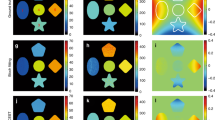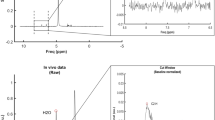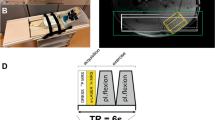Abstract
ATP derived from the conversion of phosphocreatine to creatine by creatine kinase provides an essential chemical energy source that governs myocardial contraction. Here, we demonstrate that the exchange of amine protons from creatine with protons in bulk water can be exploited to image creatine through chemical exchange saturation transfer (CrEST) in myocardial tissue. We show that CrEST provides about two orders of magnitude higher sensitivity compared to 1H magnetic resonance spectroscopy. Results of CrEST studies from ex vivo myocardial tissue strongly correlate with results from 1H and 31P magnetic resonance spectroscopy and biochemical analysis. We demonstrate the feasibility of CrEST measurement in healthy and infarcted myocardium in animal models in vivo on a 3-T clinical scanner. As proof of principle, we show the conversion of phosphocreatine to creatine by spatiotemporal mapping of creatine changes in the exercised human calf muscle. We also discuss the potential utility of CrEST in studying myocardial disorders.
This is a preview of subscription content, access via your institution
Access options
Subscribe to this journal
Receive 12 print issues and online access
$209.00 per year
only $17.42 per issue
Buy this article
- Purchase on Springer Link
- Instant access to full article PDF
Prices may be subject to local taxes which are calculated during checkout





Similar content being viewed by others
References
Balaban, R.S., Chesnick, S., Hedges, K., Samaha, F. & Heineman, F.W. Magnetization transfer contrast in MR imaging of the heart. Radiology 180, 671–675 (1991).
Bax, J.J., de Roos, A. & van Der Wall, E.E. Assessment of myocardial viability by MRI. J. Magn. Reson. Imaging 10, 418–422 (1999).
Kim, H.W., Farzaneh-Far, A. & Kim, R.J. Cardiovascular magnetic resonance in patients with myocardial infarction: current and emerging applications. J. Am. Coll. Cardiol. 55, 1–16 (2009).
Beek, A.M. et al. Delayed contrast-enhanced magnetic resonance imaging for the prediction of regional functional improvement after acute myocardial infarction. J. Am. Coll. Cardiol. 42, 895–901 (2003).
Schwitter, J. & Arai, A.E. Assessment of cardiac ischaemia and viability: role of cardiovascular magnetic resonance. Eur. Heart J. 32, 799–809 (2011).
Kim, R.J. et al. The use of contrast-enhanced magnetic resonance imaging to identify reversible myocardial dysfunction. N. Engl. J. Med. 343, 1445–1453 (2000).
Bax, J.J. et al. Metabolic imaging using F18-fluorodeoxyglucose to assess myocardial viability. Int. J. Card. Imaging 13, 145–155, discussion 157–160 (1997).
Kitagawa, K. et al. Acute myocardial infarction: myocardial viability assessment in patients early thereafter comparison of contrast-enhanced MR imaging with resting 201Tl SPECT. Single photon emission computed tomography. Radiology 226, 138–144 (2003).
Bonow, R.O. & Dilsizian, V. Thallium 201 for assessment of myocardial viability. Semin. Nucl. Med. 21, 230–241 (1991).
Bax, J.J. & Van der Wall, E.E. Assessment of myocardial viability: guide to prognosis and clinical management. Eur. Heart J. 21, 961–963 (2000).
Crane, P., Laliberte, R., Heminway, S., Thoolen, M. & Orlandi, C. Effect of mitochondrial viability and metabolism on technetium-99m-sestamibi myocardial retention. Eur. J. Nucl. Med. 20, 20–25 (1993).
Dzeja, P.P., Redfield, M.M., Burnett, J.C. & Terzic, A. Failing energetics in failing hearts. Curr. Cardiol. Rep. 2, 212–217 (2000).
Reimer, K.A., Jennings, R.B. & Tatum, A.H. Pathobiology of acute myocardial ischemia: metabolic, functional and ultrastructural studies. Am. J. Cardiol. 52, 72A–81A (1983).
Bottomley, P.A. & Weiss, R.G. Non-invasive magnetic-resonance detection of creatine depletion in non-viable infarcted myocardium. Lancet 351, 714–718 (1998).
Beer, M. et al. Absolute concentrations of high-energy phosphate metabolites in normal, hypertrophied, and failing human myocardium measured noninvasively with 31P-SLOOP magnetic resonance spectroscopy. J. Am. Coll. Cardiol. 40, 1267–1274 (2002).
Neubauer, S. et al. Absolute quantification of high energy phosphate metabolites in normal, hypertrophied and failing human myocardium. MAGMA 11, 73–74 (2000).
Nakae, I. et al. Proton magnetic resonance spectroscopy can detect creatine depletion associated with the progression of heart failure in cardiomyopathy. J. Am. Coll. Cardiol. 42, 1587–1593 (2003).
Metzler, B. et al. Decreased high-energy phosphate ratios in the myocardium of men with diabetes mellitus type I. J. Cardiovasc. Magn. Reson. 4, 493–502 (2002).
Bottomley, P.A., Atalar, E. & Weiss, R.G. Human cardiac high-energy phosphate metabolite concentrations by 1D-resolved NMR spectroscopy. Magn. Reson. Med. 35, 664–670 (1996).
Hu, Q. et al. Profound bioenergetic abnormalities in peri-infarct myocardial regions. Am. J. Physiol. Heart Circ. Physiol. 291, H648–H657 (2006).
Zhou, J., Payen, J.F., Wilson, D.A., Traystman, R.J. & van Zijl, P.C. Using the amide proton signals of intracellular proteins and peptides to detect pH effects in MRI. Nat. Med. 9, 1085–1090 (2003).
van Zijl, P.C., Jones, C.K., Ren, J., Malloy, C.R. & Sherry, A.D. MRI detection of glycogen in vivo by using chemical exchange saturation transfer imaging (glycoCEST). Proc. Natl. Acad. Sci. USA 104, 4359–4364 (2007).
Ling, W., Regatte, R.R., Navon, G. & Jerschow, A. Assessment of glycosaminoglycan concentration in vivo by chemical exchange-dependent saturation transfer (gagCEST). Proc. Natl. Acad. Sci. USA 105, 2266–2270 (2008).
Gilad, A.A. et al. Artificial reporter gene providing MRI contrast based on proton exchange. Nat. Biotechnol. 25, 217–219 (2007).
Haris, M., Cai, K., Singh, A., Hariharan, H. & Reddy, R. In vivo mapping of brain myo-inositol. Neuroimage 54, 2079–2085 (2011).
Cai, K. et al. Magnetic resonance imaging of glutamate. Nat. Med. 18, 302–306 (2012).
Haris, M. et al. Exchange rates of creatine kinase metabolites: feasibility of imaging creatine by chemical exchange saturation transfer MRI. NMR Biomed. 25, 1305–1309 (2012).
Arús, C., Barany, M., Westler, W.M. & Markley, J.L. 1H NMR of intact muscle at 11 T. FEBS Lett. 165, 231–237 (1984).
Reijenga, J.C. Comparison of methanol and perchloric acid extraction procedures for analysis of nucleotides by isotachophoresis. J. Chromatogr. A 374, 162–169 (1986).
Woo, D.-C. et al. Regional absolute quantification of the neurochemical profile of the canine brain: investigation by proton nuclear magnetic resonance spectroscopy and tissue extraction. Appl. Magn. Reson. 38, 65–74 (2010).
Bottomley, P.A. & Weiss, R.G. Noninvasive localized MR quantification of creatine kinase metabolites in normal and infarcted canine myocardium. Radiology 219, 411–418 (2001).
Liu, G., Gilad, A.A., Bulte, J.W., van Zijl, P.C. & McMahon, M.T. High-throughput screening of chemical exchange saturation transfer MR contrast agents. Contrast Media Mol. Imaging 5, 162–170 (2010).
Laser, A. et al. Regional biochemical remodeling in non-infarcted tissue of rat heart post-myocardial infarction. J. Mol. Cell. Cardiol. 28, 1531–1538 (1996).
Bottomley, P.A., Lee, Y. & Weiss, R.G. Total creatine in muscle: imaging and quantification with proton MR spectroscopy. Radiology 204, 403–410 (1997).
Francescato, M.P., Cettolo, V. & di Prampero, P.E. Influence of phosphagen concentration on phosphocreatine breakdown kinetics. Data from human gastrocnemius muscle. J. Appl. Physiol. 105, 158–164 (2008).
van Vaals, J.J. et al. “Keyhole” method for accelerating imaging of contrast agent uptake. J. Magn. Reson. Imaging 3, 671–675 (1993).
Song, H.K. & Dougherty, L. k-space weighted image contrast (KWIC) for contrast manipulation in projection reconstruction MRI. Magn. Reson. Med. 44, 825–832 (2000).
Schroeder, M.A. et al. Hyperpolarized magnetic resonance: a novel technique for the in vivo assessment of cardiovascular disease. Circulation 124, 1580–1594 (2011).
Lamb, H.J. et al. Metabolic response of normal human myocardium to high-dose atropine-dobutamine stress studied by 31P-MRS. Circulation 96, 2969–2977 (1997).
Bottomley, P.A. Spatial localization in NMR spectroscopy in vivo . Ann. NY Acad. Sci. 508, 333–348 (1987).
Acknowledgements
This work was supported by National Institutes of Health grants P41 EB015893, P41 EB015893S1 and R21DA032256-01 and a pilot grant from the Translational Biomedical Imaging Center of the Institute for Translational Medicine and Therapeutics of the University of Pennsylvania. The authors acknowledge W. Liu and S. Pickup for technical assistance in using the 9.4-T NMR spectrometer, K. Nath for assistance with biochemical analysis and D. Reddy for help with regulatory protocol.
Author information
Authors and Affiliations
Contributions
M.H. and A.S. designed and performed experiments, analyzed data and wrote the manuscript; K.C. provided technical support with animal studies and helped with manuscript editing; F.K. performed experiments and helped with human subject scanning and manuscript editing; J.M. helped with animal handling and manuscript editing; C.D. helped with human subject scanning; G.A.Z. helped with animal handling and scanning; W.R.T.W. provided technical support with animal imaging; and K.K. and J.J.P. helped with animal handling and preparation for imaging. J.A.C., V.A.F. and J.H.G. advised on cardiovascular imaging aspects and contributed to manuscript editing; H.H. provided pulse sequence design and technical guidance and contributed to the manuscript writing; R.C.G. helped with animal experimental design and contributed to manuscript editing; and R.R. conceived of and designed the study and contributed to manuscript writing and editing.
Corresponding author
Ethics declarations
Competing interests
The authors declare no competing financial interests.
Supplementary information
Supplementary Text and Figures
Supplementary Discussion and Supplementary Methods (PDF 3580 kb)
Rights and permissions
About this article
Cite this article
Haris, M., Singh, A., Cai, K. et al. A technique for in vivo mapping of myocardial creatine kinase metabolism. Nat Med 20, 209–214 (2014). https://doi.org/10.1038/nm.3436
Received:
Accepted:
Published:
Issue Date:
DOI: https://doi.org/10.1038/nm.3436
This article is cited by
-
Machine Learning Identification Framework of Hemodynamics of Blood Flow in Patient-Specific Coronary Arteries with Abnormality
Journal of Cardiovascular Translational Research (2023)
-
Creatine chemical exchange saturation transfer (CEST) CMR imaging reveals myocardial early involvement in idiopathic inflammatory myopathy at 3T: feasibility and initial experience
European Radiology (2023)
-
Intradiscal quantitative chemical exchange saturation transfer MRI signal correlates with discogenic pain in human patients
Scientific Reports (2021)
-
Differentiation of low- and high-grade pediatric gliomas with amide proton transfer imaging: added value beyond quantitative relaxation times
European Radiology (2021)
-
Cardiac 1H MR spectroscopy: development of the past five decades and future perspectives
Heart Failure Reviews (2021)



